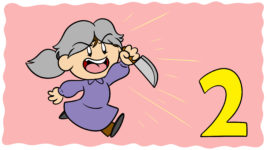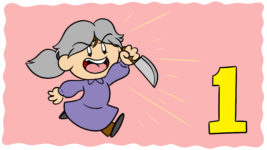A character’s ‘arc’ describes their internal journey over the course of a story, generally occasioned by the external events they encounter as it unfolds. If the person they are when they begin the book is where they ‘launch’ and the person they are at the end is where they ‘land’, then the path from one to the other is their ‘arc.’ Every fictional character worth their salt, from Harry Potter to Raskolnikov to Holden Caulfield, has one (even if they ultimately ‘land’ back where they started.)
Ever since stories were just things we told around the cave fire to distract everyone from Og’s grotesquely infected knee, characters have been defined by their arcs: we remember Hercules for his gradual, incremental maturity (from ‘zero to hero,’ as Disney put it); Odysseus for his up-one-moment, down-the-next progression; and Bilbo Baggins for the gradual and satisfying emergence of his surprising inner strength and courage.
But, paradoxically, not every character needs to change to have an arc; while, yes, characters like Raskolnikov and Theon Greyjoy are dramatically transformed and redeemed by the end of their stories, others, like Marvel’s Captain America, every TV sitcom character ever, and any number of villains (Sauron, for example, or Ramsay Bolton, or Voldemort), stay the same while the world changes around them.
So, are character arcs binary, with some characters changing and others just not? The short answer is ‘no.’ As for the long answer…
Internal and external plots
A character, like any person, is unique, and while they may experience the same events, each should have a unique response. It is these elements – the events and the responses – that define a character’s arc.
Let’s take A Song of Ice and Fire’s Theon Greyjoy. He’s given away by his family and becomes a ward of Ned Stark, which he seems to take pretty well, befriending his new siblings and behaving nicely. However, fast-forward and, when given the opportunity to betray the Starks, he takes it, revealing his ambition and planting the seed of a wretched guilt that will haunt him for the rest of his life. He plays the villain for a while before falling into the hands of Ramsay Bolton, who tortures him horribly and relentlessly, eventually emasculating him and reducing him to a whimpering slave. But, confronted with the mistreatment of Sansa Stark, Theon finds some of that old fire and, with Sansa, stages a daring escape. From here, his redemption arc begins – he slowly deals with his trauma, recovers his old courage, and (in the TV series at least) eventually dies a hero’s death defending his little brother.
As you can see, a character’s arc – which, together with other characters’ arcs, makes up a book’s internal plot – relies on external events in order to get going. If Theon had never been given the opportunity to betray the Starks (an external event), his arc would look extremely different, but because of George R.R. Martin’s manipulation of the external plot (i.e. the actual events of the story, as opposed to the changes in its characters), Theon’s internal plot – the changes in his own personality, psychology, and social/physical circumstances – is able to play out.
The calculated binding together of external and internal plots is vital when considering your characters’ arcs. After all, if you’re to create a compelling internal plot, you’ll need to ensure the external plot moves in such a way as to instigate and enable those internal changes. This can be easier said than done, especially as you should also be trying to keep your book’s central conflict in focus.
For example, you may want your primary antagonist, a particularly tyrannical office boss, to suffer some tragedy that instigates her psychological decline – the death of her son, perhaps. But, to make this work, you have to fit this pretty major event (death is rarely a small thing) into your external plot, the central conflict of which follows your protagonist as he goes from miserable office nobody to enlightened free spirit (yes, it’s basically The Secret Life of Walter Mitty).
Now, maybe you can make this work without much hassle – maybe there isn’t much else going on early in your story. But maybe, by inserting a death into your early chapters, you’re cramming too much in and unbalancing your plot, or maybe you’re distracting from other early-book events or are drawing too much attention away from the progression of the central conflict.
These are all vital things to pay attention to when planning your book’s internal and external plots. Structural balance is key, and too many books suffer from sagging middles due to dissonance between the internal plots of their characters and the external plots of their grand narrative. Thankfully, there’s a great cure for this: giving your characters different arcs.
Types of character arc
In a fantastic YouTube video, Wisecrack’s Gerard compares the distinct character arcs of Marvel movie heroes Captain America, Iron Man, and Thor, and discusses how these arcs interact and are expressed in Avengers: Endgame.
Thor’s arc, he says, is cyclical – over seven movies, Thor starts high, falls low, regains his former position, finds himself brought even lower than before, and so on and so forth. With each cycle, there’s a little incremental progression – Thor as a persistent character presumably learns lessons from his constant revolutions (though these aren’t communicated especially well in the films), but ultimately his arc is circular. In this way, he’s similar to Odysseus in The Odyssey – during his travels, Odysseus constantly bounces between success and failure, success and failure, never enjoying his victories or lamenting his defeats for long.
Iron Man’s arc, meanwhile, is totally transformative – like, for example, Crime and Punishment’s Raskolnikov or 1984’s Winston Smith, he is, due to external events, a totally different man at the end of the story than he was at the start. It’s worth noting here that, unlike characters such as Bilbo Baggins and Harry Potter (who, it is suggested, grow through the discovery and channeling of their own previously hidden personal resources), characters like the selfish, Randian Iron Man, along with Winston and Raskolnikov, change – that is, they don’t meet their pre-existing potential, but instead embark on a whole new path.
Then there’s Captain America who, like any number of literary characters, from Lolita’s Humbert Humbert to The Stranger’s Meursault, doesn’t change. Instead, the world changes around him, rubbing up against him and ricocheting off of him, creating all manner of external plot points. This style of arc is interesting in that the regular process of external plot influencing internal plot is reversed; instead of the story changing the character, the character shapes the plot through their refusal to change.
Of course, there are plenty of other kinds of character arc: some characters straightforwardly ascend while others relentlessly decline, some change physically while remaining constant psychologically, and still others change their perspectives but not their circumstances. Whatever arc or combination you opt for, it’s important to consciously choose what happens to your characters and how they respond.
Of course, the idea isn’t to figure out the best kind of arc and use it for everyone – it’s to figure out the best kind of arc for each character.
Why vary your arcs?
Varying your character arcs is a great idea for a huge number of reasons. For one, it’s authentic – in the real world, people face different challenges and obstacles and respond in different ways. By ensuring your book is reflecting this truth, you’re helping your characters seem like real, breathing people rather than flat narrative archetypes, and that helps ensure reader engagement.
Beyond this, varying your character arcs is great for both the development of your individual characters and for the progression and structuring of your plot. To quote the Bible, ‘As iron sharpens iron, so one person sharpens another.’
Indeed, moments when characters with different arcs (and thus different outlooks and attitudes) clash are often productive moments of high drama that alter the direction of the external plot or even spawn whole new subplots. To return to the Marvel characters, think of how Captain America and Iron Man’s philosophical and physical clashes throughout their films and comics become significant plot points, or, to use a literary example, think of how, in Dostoyevsky’s The Idiot, Prince Myshkin’s character arc and his static personality – his enduring simplicity, kindness, and sensitivity – so enrage Ganya that Ganya’s response becomes the inciting incident that drives the book’s central conflict. At the same time, this conflict emphasizes the depth and authenticity of both Ganya and Myshkin’s characters.
This is a great example of how clashes between characters with different types of arc can maintain forward momentum, keeping your book’s plot tight and its pace consistent all while encouraging reader investment.
Arc toward justice
Even if you ultimately choose fairly simple or archetypal arcs for your characters (borrowing, perhaps, from Jungian character archetypes or from Joseph Campbell’s Hero’s Journey), the simple act of thinking about how your characters’ arcs unfold and interact will be enough to improve your writing.
After all, it’s all too easy to just dive into your fiction with an idea of your central plot while assuming your characters will go along with it – that is, it’s easy to focus on your external plot while ignoring your internal plot. This, however, would be a huge mistake. It is, after all, more often than not the internal drama that readers remember once the book is done. What do we remember from Lolita? Humbert driving across America, or his twisted (and beautifully written) attempts to justify his mounting atrocities? Or, to use an example from film, would Luke and Darth Vader’s external conflict be anywhere near as exciting if the audience hadn’t experienced the internal drama that grants meaning to their eventual combat?
Of course, the best books successfully bind the internal plot to the external plot. Think of how Raskolnikov’s final redemption and his acceptance of love are reflected externally in his banishment to Siberia at the end of Crime and Punishment, or how, in Carys Davies’ wonderful West, the sudden maturing of Bess from a dependent girl to an independent woman (an internal arc) is ushered in and wonderfully encompassed by both the awful violence she’s endured and the cathartic and symbolic act of vengeance that frees her from that violence.
So before you get started on that next story, think about your characters – who are they? What happens to them? How do they respond and, crucially, how do their responses influence how they interact with other characters with different arcs?
Good luck finding your own unique answers! While you’re thinking, share some examples of characters with different types of arc below, and get more great advice on this subject with Does Every Story Need A Character Arc? and How To Write Compelling Character Arcs In A Series.





